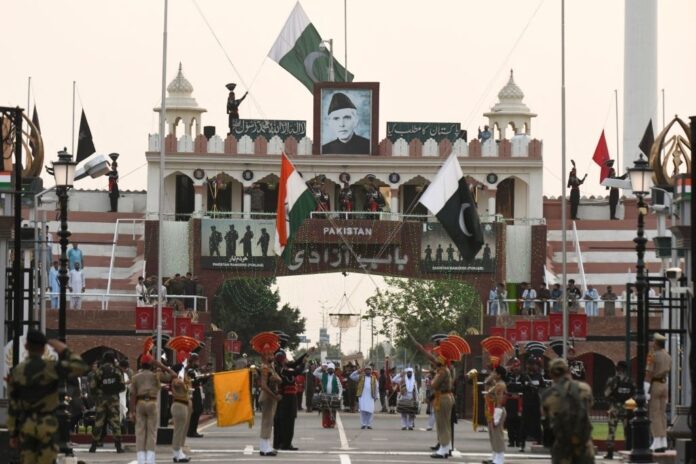ISLAMABAD: The nuclear capabilities of Pakistan and India have maintained a “strategic and military” balance not only between the two South Asian neighbours but also with New Delhi’s eastern rival China, say defense and security experts.
On the eve of the 24th anniversary of the nuclear tests conducted by the archrivals in May 1998, experts from both countries reckon that the presence of nuclear warheads has reduced the chances of full-scale wars between nuclear rivals.
But it has nevertheless raised fears about nuclear safety.
India conducted five nuclear tests from May 11-13, 1998 in the Pokhran range of Rajasthan state, which borders Sindh, triggering a new arms race in the already tense region.
Only two weeks later, Pakistan conducted six “successful” nuclear tests in the remote Chaghi district of Balochistan on May 28.
“Pakistan’s nuclear capability has not only established strategic stability between New Delhi and Islamabad, but it also acts as a bulwark against the aggression,” said Maria Sultan, an Islamabad-based security expert who often writes about nuclear issues.
Speaking to Anadolu Agency, Sultan, who heads an Islamabad-based think tank, the South Asian Strategic Stability Institute, said that Pakistan’s nuclear ability has not only helped establish a deterrence between the two nuclear rivals but also helped mitigate the “threat of global war efforts from spreading in the region beyond the international parameters”.
Sameer Patil, a senior fellow at India’s Observer Research Foundation (ORF) think tank, said that “nuclear technology, particularly in the case of India, has been one of the under-appreciated reasons for maintaining the military balance in the region.”
Patil said that New Delhi’s nuclear capability has reduced the chances of a large-scale war with neighbouring China.
“India’s ability to readily perform under both peace and wartime conditions is the direct result of India’s nuclear technology, which has evolved over the years to maintain a credible minimum deterrence in the region, comprising three nuclear powers — China, India, and Pakistan,” he said.
Sharing a similar view, Soumya Awasthi, a New Delhi-based defense analyst, said “India’s nuclear capabilities along with the existing leadership have amplified the deterrence between India and China and India and Pakistan.”
“The cue can be taken from India’s stance over the 2019 Pulwama attack (in Indian-administered Kashmir) and the (ongoing) standoff between India and China in Ladakh,” she said.
Nuclear safety concerns
“Nuclear weapons are primarily weapons of non-use, and their use and strength lie if they can create a deterrence and able to stop the threat of large-scale war against a country,” said Sultan.
“There are no serious concerns about the safety of nuclear weapons. Both Pakistan and India have maintained required safety protocols in this regard,” he added.
Citing the “accidental” launch of an Indian cruise missile into Pakistan in March, which caused no casualties, Sultan nevertheless raised concerns about the safety of radioactive material, mainly at civilian nuclear facilities.
She called for the establishment of an independent regulatory authority by the two nuclear countries to ensure the “safety and security of the nuclear materials, processes and facilities.”
Commenting on some recent uranium theft incidents in India, she said that “unfortunately, the case of uranium theft in India is not small but indicates a larger problem of the safety and security mechanisms in place in India to secure its nuclear arsenal.”
Awasthi said India “responsibly” acknowledged the accidental firing of the unarmed missile into Pakistan.
“However, it does raise concern over the technical malfunction, but good sense prevailed, and any sort of escalation was avoided,” added Awasthi, who is a co-author of the upcoming book Biographic Tale of the Indian Nuclear Program.
Describing the accidental firing of the missile as a one-off incident, she said the government has ensured proper investigations into it.
Slim chances of nuclear war
Experts from both sides see “very slim” chances of a nuclear war between the two neighbours, who have long been locked in a string of land and sea disputes, notably the lingering Kashmir issues.
Kashmir is held by India and Pakistan in parts and claimed both in full. A small sliver of Kashmir is also held by China.
Since they were partitioned in 1947, the two countries have fought four wars — in 1948, 1965, 1971, and 1999. Three of them were over Kashmir.
“In my view, there exist very slim or minimal chances of (a) nuclear war between the two countries, “said Munawar Hussain Panhwer, an assistant professor at Quaid-i-Azam University in Islamabad.
Enumerating the factors in favour of his argument, he cited no occurrence of a major war between the two adversaries since they acquired the status of declared nuclear powers.
“It indicates that deterrence works between the two nations,” he maintained.
Since 1998, there were at least three occasions when the two nuclear-armed neighbours were on the brink of a full-fledged war — the 1999 Kargil skirmish, the 2002 terrorist attack on India’s parliament, and the 2008 Mumbai attacks.
Secondly, both sides also possess a second-strike capability that assures mutual destruction.
“The stakes of the international community are high in the South Asian region. They in the past have managed crises between the two arch-rivals and would do the same in the future,” he further said.
Citing the economic hardships and grinding poverty the two neighbours have been grappling with, Panhwer added: “The lethality of the traditional weapons has become accurate, which makes the balance of terror more credible. So, both states would likely prefer a very limited war just like the Kargil crisis rather than a nuclear one.”
Supporting the argument, Patil said: “There is a slim chance of a nuclear war between India and Pakistan because both countries realize the destruction that would be caused by the nuclear exchange.”
“While Pakistan has engaged in nuclear sabre-rattling on many occasions, it has been primarily for coercive purposes rather than actual deployment of nuclear weapons,” he said.
Awasthi said: “Nuclear weapons are political weapons and not war-fighting weapons. They are merely used as a tool of deterrence.”
India boasts the world’s third-largest army after the US and China, with an active troop strength of over 1.3 million. Pakistan, meanwhile, stands eighth on the list with a 600,000-man army.
India has been the second-largest arms importer in the world over the past five years, with Pakistan ranking 11th, according to the Sweden-based Stockholm International Peace Research Institute (SIPRI).
Pakistan and India are among a few select countries with nuclear arsenals. India joined the nuclear club long before Pakistan, in 1974, prompting Islamabad to follow suit. Pakistan silently developed its nuclear capability in the 1980s, when it was an ally of the US in the first Afghanistan war against the crumbling Soviet Union.
According to SIPRI, India currently possesses between 80 and 100 nuclear warheads, while Pakistan holds between 90 and 110.
Meanwhile, several international think tanks which blame China for assisting Pakistan’s nuclear program believe the size of Islamabad’s nuclear arsenal will cross the 200-mark within the next five years.






















